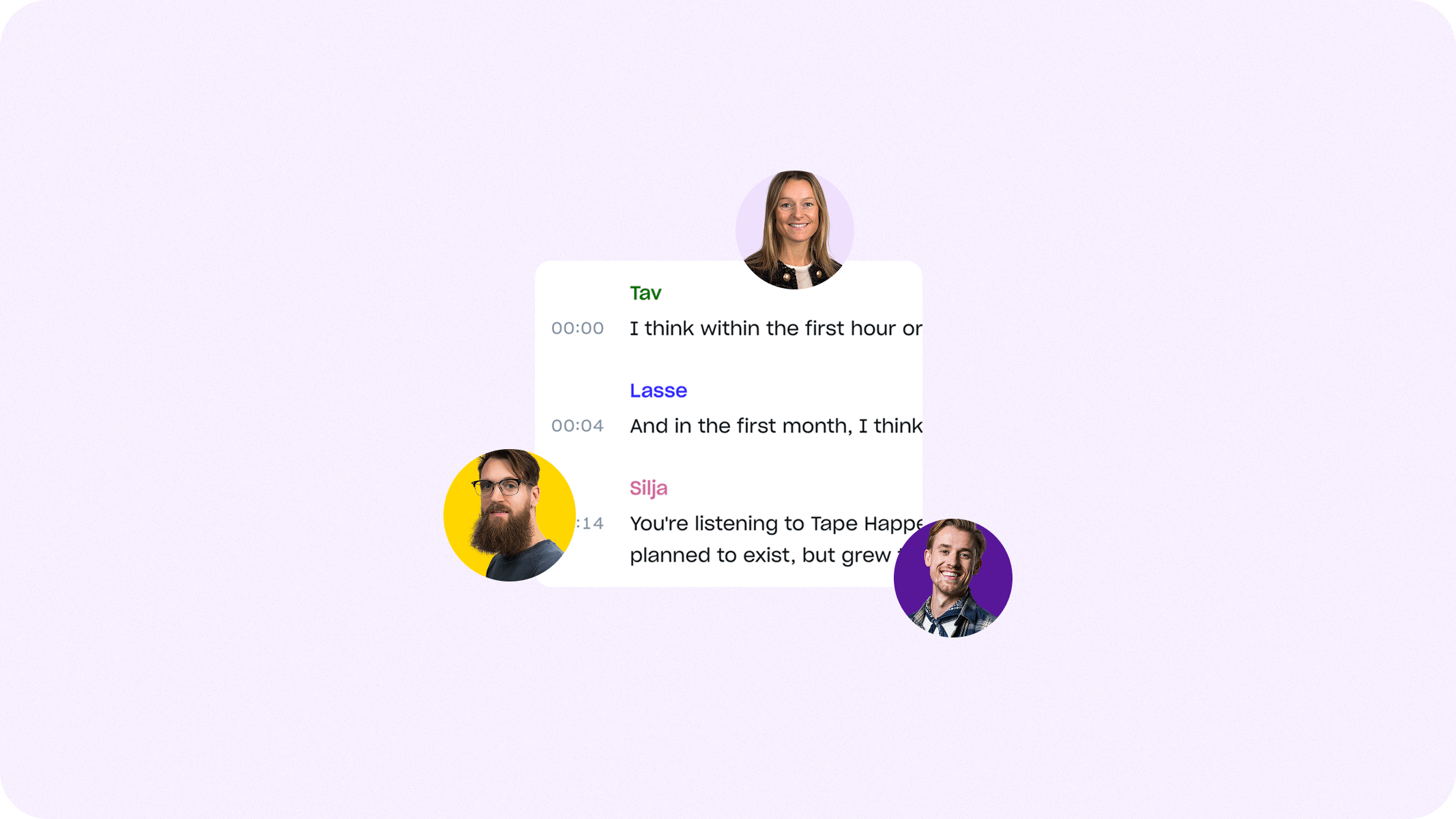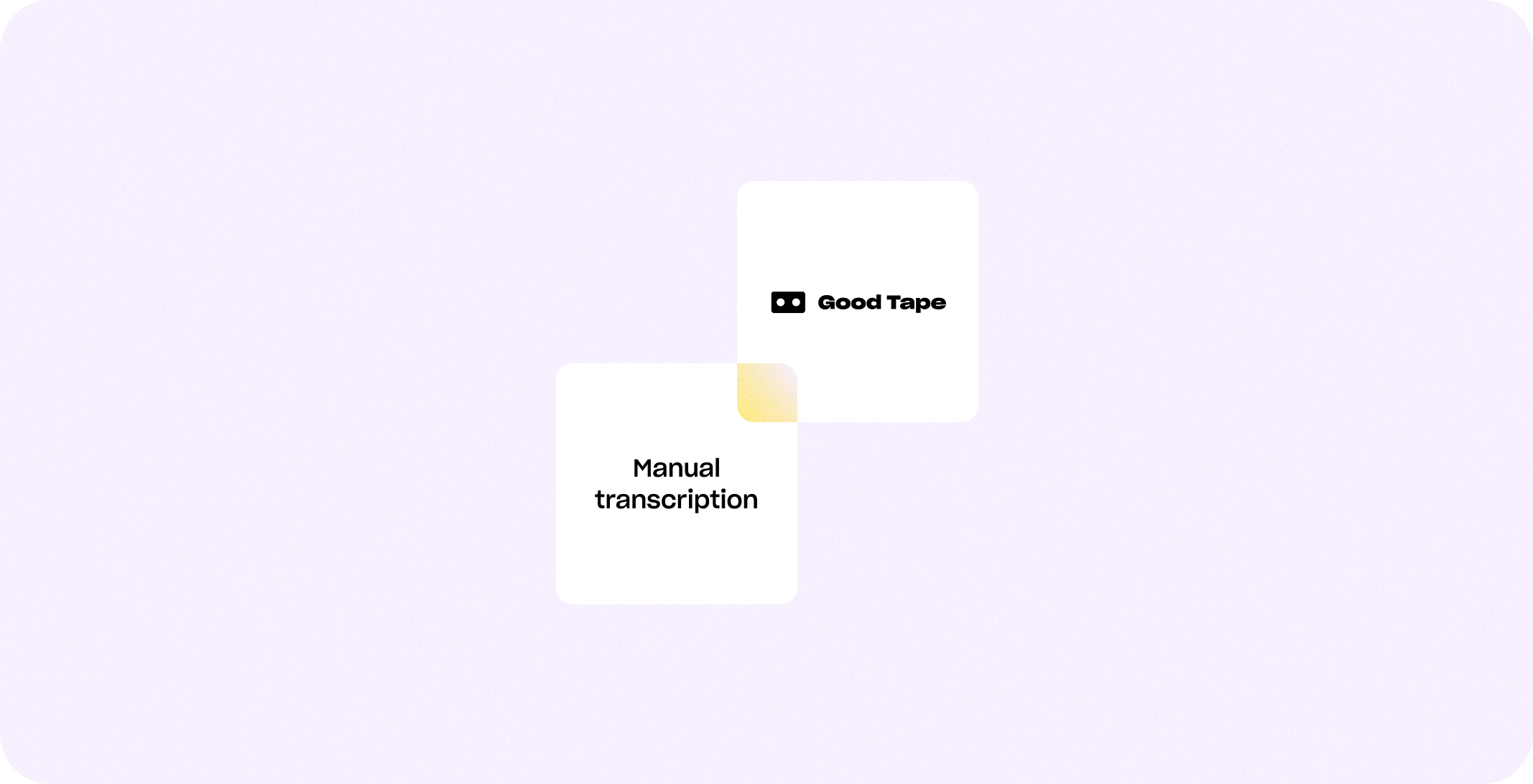Creating effective interview transcripts for your dissertation

Summary
- Interview transcripts form the backbone of your dissertation’s qualitative analysis.
- Use Good Tape transcription to capture every word, emotion, and nuance.
- Follow APA guidelines for structure, speaker labels, and citations.
- Transcription tools like Good Tape make the process faster, more accurate, and GDPR-safe.
- Clean, consistent transcripts improve both readability and academic credibility.
Have you ever thought about how your dissertation’s disorganised interview notes become a logical and informative chapter to your work? Transcription is the key. Transcripts serve as the foundation for qualitative data analysis and are frequently used in dissertations as vital support and proof.
A keen eye for detail and strict adherence to particular formatting requirements are necessary for creating the ideal dissertation. Moving forward, we will be discussing all you need to know about qualitative interviews, transcribing for them, and how to write an interview transcript in an APA format.
We’ve also linked a few exemplar interview transcript dissertations at the end of this which you can follow as a guide.
A guide to writing an interview transcript for dissertation
Writing an interview transcript for a dissertation requires balancing academic standards for compliance, accuracy, and coherence. The interviewee’s details and variations are conveyed in this transcript, which not only provides essential support for your study but also adds depth and richness to your dissertation.
Here’s how you can improve your process of transcribing interviews qualitative research:
- To get a feel of the whole topic and context, start by listening to the entire interview tape at least once, without stopping.
- Write down every word that was spoken during the interview in a verbatim transcription. This covers every word said, even if they are filler or repeats that don’t hinder comprehension or reading. Here you can make use of transcription services like Good Tape, which are competitively priced and have a much shorter turnaround time than manual transcription.
- Pay attention to relevant non-verbal clues and pauses since they might reveal more about the interviewee’s feelings and reactions.
- Make sure your transcript follows a clear, uniform structure. Timestamps, speaker labels, and paragraph breaks for new subjects or questions to be included in this.
- After the initial transcription, check and revise the transcript to ensure it is coherent and clear, according to the original.
By following this process you can effectively change the organic flow of a spoken interview into an instructive and captivating written style.
Interview transcription – A hypothetical case scenario
A recent dissertation from a Ph.D. candidate at an internationally recognised college provides an excellent illustration of the significance of transcripts from interviews when working on dissertations.
The researcher performed a number of in-depth interviews with locals, municipal planners, and company owners in order to better understand how urban expansion affects local communities. Every interview provided a different viewpoint on how the community views urban development initiatives and their effects.
Rather than manually transcribing several interview recordings or listening to them on a loop, the researcher employed transcription services to speed up their work.
Services like Good Tape ensure that your data remain protected and secure throughout the entire process as they are fully GDPR compliant, giving you peace of mind that your research is not getting into the wrong hands.
The dissertation’s use of direct excerpts from the transcriptions gave the study results a stronger, more genuine voice. As a result, the dissertation’s quality was enhanced and the reader and research subjects felt more personally connected. Because of this, the dissertation demonstrated the significant effects of urban growth on several stakeholders while being both academically demanding and very relevant to experiences and viewpoints from the real world.
How to write an interview transcript in an APA format
To guarantee that the transcript is accurate, comprehensible, and follows the rules set out by the Publication Manual of the American Psychological Association (APA), writing an interview transcript in APA style requires a certain approach. The actions to take are as follows:
- Header information: Put a title that accurately summarises the interview’s topic at the beginning of the transcript, along with any important identifying details like the interview date and the names of the interviewer and interviewee.
- Speaker identification: Throughout the transcript, be sure to distinguish between the interviewer and the interviewee. Before every conversation line, use their names or titles (e.g., ‘Interviewer:’ and ‘Respondent:’).
- Exact transcription: Enter the words exactly as they were said in the transcription. Incorporate all spoken words, such as “um” and “uh,” unless their inclusion hinders comprehension of the conversation.
- Nonverbal cues: The main nonverbal clues are indicated in parentheses. For instance, you can include [pauses], [laughs], or [sighs] if they provide background information for the discussion.
- Paragraph structure: Whenever the speaker or topic changes, a new paragraph should be started. This improves readability and aids in the logical organisation of the text.
- Editing and proofreading: Verify that the transcript is grammatically and typographically correct. Make sure the text is comprehensible and clear without sacrificing the authenticity of the spoken word.
- In-text citations: Use the proper APA style citations when referencing your transcript inside the body of your dissertation.
While the answer to how to write an interview transcript in APA format is clear now, it is important to understand that while doing so, you are not only making your work more academically acceptable but also improving its readability score.
The procedure of following APA criteria for your dissertation may be greatly streamlined by using a transcription service, which will make the process much more effective and time-saving. Good Tape offers services in this regard which allows you to transcribe your interview audios adhering to the APA standard in no time.
Investing in a professional service guarantees that your interview transcripts are prepared in accordance with APA guidelines and are exactly as is, capturing every word and subtle emotion from the interviewee.
FAQ about interview transcripts in a dissertation
Transcripts from interviews are an essential component of dissertation work, especially in the humanities, social sciences, and qualitative research. However, it’s common to have certain pressing questions at this stage. We have addressed a few that might help clear things up a bit for you.
Do you include interview transcripts in a dissertation?
Indeed, it is typical practice to include interview transcripts in dissertations, particularly in qualitative research. Readers may examine the precise data that was used to form conclusions by reading transcripts, which offer a thorough and accurate record of the interviews that were done.
Why get an interview transcription for a dissertation?
For dissertations, transcriptions are essential because they translate spoken language into a written form that is simple to examine. They make it possible to look more closely at the data and make it easier to find themes, patterns, and subtleties in the replies.
What kind of transcription do I need for my dissertation?
A verbatim transcription is chosen for the majority of dissertations. In order to fully capture the context of the interview and the interviewee’s meaning, it is necessary to transcribe exactly what was said, including any filler words and non-verbal cues. Nonetheless, you may choose a clean transcription, which eliminates irrelevant phrases and fixes grammar for readability, based on the subject matter of your study.
How do I format interview transcripts for a dissertation?
Transcripts of interviews should be formatted according to the requirements of your university or the particular style guide you are using, like APA or MLA. This usually entails using non-verbal clues, maintaining consistency in paragraph layout, and having a clear framework for identifying speakers.
Can I use automated transcription services for my dissertation interviews?
Using automated transcription services that use AI to transcribe audio into text can be quite beneficial as they help save a lot of time. However, you need to be sure that the service you’re employing is suitable for your needs and serves the purpose well.
Revolutionize your interview analysis process with Good Tape
Having a good transcription service to convert your audio interviews into written documents speeds up your dissertation structuring and writing process. You can spend more time analysing and improving the overall quality of your dissertation rather than on listening to the recordings on loop. This is where Good Tape comes to your aid.
Trusted by professionals and teams
Want to read more?
Check out these related resources
Help center (FAQ)
What is an interview transcript for a dissertation?
It’s a written record of your recorded interviews, capturing every word, pause, and emotion. These transcripts form the backbone of your qualitative analysis and make your dissertation more structured and verifiable.
Do I need to include interview transcripts in my dissertation?
Yes. Especially for qualitative research. Including them gives transparency to your findings and helps readers trace how you drew your conclusions.
Should I transcribe interviews verbatim or clean them up?
Most dissertations require verbatim transcription — meaning every word, pause, and filler is included. However, for readability, a clean verbatim version may be acceptable depending on your university’s guidelines.
Is Good Tape free to use?
Yes. Good Tape offers a free plan so anyone can start transcribing without a credit card. Test in and upgrade to Pro later.
Why should I use Good Tape?
It’s built for accuracy, speed, and simplicity. Helping you focus on storytelling instead of manual transcription.
Is Good Tape secure?
Yes. Good Tape provides secure and accurate transcriptions that you can rely on. We are fully GDPR compliant. We will never train on your data. Your data is yours and you remain in control.
Can I use AI transcription tools like Good Tape for my dissertation?
Absolutely. Good Tape provides fast, accurate, and secure transcription. Ideal for academic work. It saves you hours of manual work while maintaining GDPR compliance.
Secure transcription for interviews
Discover reliable audio to video transcription


